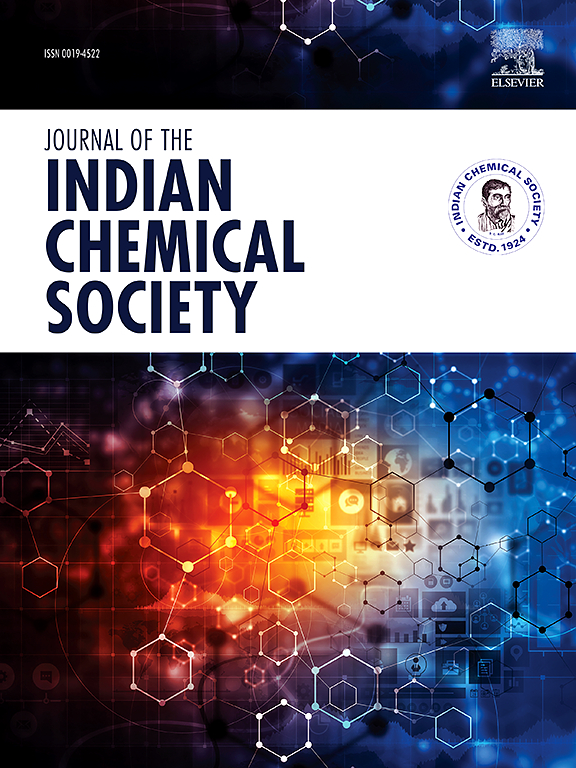AV2O6 (A = Zn, Ca, Mg)和NaBH4 -还原AV2O6:结构、光学和光催化降解亚甲基蓝的比较研究
IF 3.4
4区 化学
Q2 CHEMISTRY, MULTIDISCIPLINARY
引用次数: 0
摘要
本文研究了在可见光和日光下,AV2O6 (A = Zn, Ca, Mg)和硼氢化钠还原AV2O6 (A = Zn, Ca, Mg)光催化降解亚甲基蓝(MB)的研究结果。采用固态法合成了AV2O6化合物,并利用各种表征技术对其形貌、电子结构和光学性质进行了表征。AV2O6的还原形式,称为R-AV2O6 (A = Zn, Ca, Mg),由于改进了电荷载流子分离,与原始AV2O6材料相比,表现出优越的光催化性能。x射线衍射(XRD)分析证实,所有AV2O6材料均形成单相结构。场发射扫描电镜(FESEM)显示,ZnV2O6、CaV2O6和MgV2O6的粒径范围分别为2.5 ~ 2.8 μm、1.1 ~ 1.4 μm和0.8 ~ 1.1 μm。通过UV-Vis DRS分析,AV2O6的带隙值在2.15 ~ 2.64 eV之间,R-AV2O6的带隙值在1.78 ~ 2.52 eV之间。R-AV2O6 (A = Zn, Ca, Mg)相对MB的降解率明显高于单个AV2O6组分。基于高分辨率质谱(HRMS)分析,提出了MB的潜在降解途径。重要的是,本研究首次报道了MgV2O6和还原型AV2O6 (A = Zn, Ca, Mg)材料用于MB降解的光催化应用,建立了一类新的高效可见光和阳光活性光催化剂。本文章由计算机程序翻译,如有差异,请以英文原文为准。

AV2O6 (A = Zn, Ca, Mg) and NaBH4 - Reduced AV2O6: A Comparative study of structural, optical, and photocatalytic insights for Methylene blue degradation
In this study, we present findings on the photocatalytic degradation of methylene blue (MB) by AV2O6 (A = Zn, Ca, Mg) and sodium borohydride reduced AV2O6 (A = Zn, Ca, Mg) under both visible light and sunlight. AV2O6 compounds were synthesized via a solid-state method, and their morphology, electronic structure, and optical properties were examined using various characterization techniques. The reduced form of AV2O6, referred to as R-AV2O6 (A = Zn, Ca, Mg), exhibits superior photocatalytic performance compared to the original AV2O6 materials, attributed to improved charge carrier separation. X-ray diffraction (XRD) analysis confirmed the formation of a single-phase structure for all AV2O6 materials. Field emission scanning electron microscopy (FESEM) revealed particle sizes in the range of 2.5–2.8 μm, 1.1–1.4 μm, and 0.8–1.1 μm for ZnV2O6, CaV2O6, and MgV2O6, respectively. Analysis via UV–Vis DRS explained that the bandgap values for AV2O6 varied between 2.15 and 2.64 eV and for R-AV2O6 varied between 1.78 and 2.52 eV. R-AV2O6 (A = Zn, Ca, Mg) phases demonstrate a significantly higher degradation rate of MB compared to the individual AV2O6 components. Potential degradation pathways for MB were proposed based on high-resolution mass spectrometry (HRMS) analysis. Importantly, this research marks the first report on the photocatalytic application of MgV2O6 and reduced AV2O6 (A = Zn, Ca, Mg) materials for MB degradation, establishing a new class of efficient visible and sunlight active photocatalysts.
求助全文
通过发布文献求助,成功后即可免费获取论文全文。
去求助
来源期刊
CiteScore
3.50
自引率
7.70%
发文量
492
审稿时长
3-8 weeks
期刊介绍:
The Journal of the Indian Chemical Society publishes original, fundamental, theorical, experimental research work of highest quality in all areas of chemistry, biochemistry, medicinal chemistry, electrochemistry, agrochemistry, chemical engineering and technology, food chemistry, environmental chemistry, etc.

 求助内容:
求助内容: 应助结果提醒方式:
应助结果提醒方式:


